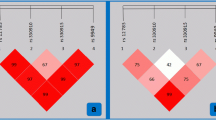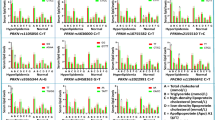Abstract
Background
There is strong evidence suggesting an association between the peroxisome-activated receptor γ (PPARγ) gene and multimetabolic disorders. The association of PPARγ genetic variants with essential hypertension (EH) has not yet been investigated. The aim of this study was to investigate the association between the PPARγ gene (C681G and intron CT) and EH, examining the polymorphism and haplotype in a Han Chinese population.
Methods
Participants were recruited within the framework of the PMMJS cohort population survey in an urban community of Jiangsu Province, China. Two single-nucleotide polymorphisms (SNPs) previously reported to be associated with multimetabolic disorders and the reasonable coverage of the PPARγ gene region were analyzed with TaqMan SNP genotyping assays.
Results
C681G and intron CT were significantly associated with an increased risk of EH both in the codominant model and the dominant model after adjusting for potential nongenetic risk factors. Analysis of the haplotype association revealed that the risk of EH was significantly increased among individuals carrying the GC (odds ratio, 95 % CI: 1.60, 1.21–2.11), CT (1.45, 1.03–2.11), and GT haplotypes (1.95, 1.17–3.23) compared with those carrying the CC haplotype.
Conclusion
The polymorphisms of C681G and intron CT were significantly associated with the risk of EH, and the GC, CT, and GT haplotypes established by C681G and intron CT are likely to be genetic markers of EH in the Han Chinese population.
Zusammenfassung
Hintergrund
Es gibt deutliche Hinweise auf einen Zusammenhang zwischen dem PPARγ-Gen („peroxisome activated receptor γ“) und multimetabolischen Störungen. Der Zusammenhang genetischer PPARγ-Varianten mit essenzieller Hypertonie ist bisher nicht untersucht worden. Ziel der vorliegenden Studie war es, den Zusammenhang zwischen dem PPARγ-Gen (C681G und Intron-CT) und essenzieller Hypertonie unter Berücksichtigung von Polymorphismus und Haplotyp in einer Population von Han-Chinesen zu untersuchen.
Methoden
Die Teilnehmer wurden im Rahmen der Populationserhebung anhand der Kohorte zur“Prevention of metabolic syndrome (MS) and Multi-metabolic Disorders in Jiangsu Province of China Study” (PMMJS) in der Stadtbevölkerung der Provinz Jiangsu, China, rekrutiert. Zwei Einzelnukleotidpolymorphismen (SNPs), die laut früheren Arbeiten mit multimetabolischen Störungen einhergehen, und – soweit sinnvoll – die PPARγ-Gen-Region wurden mit TaqMan-SNP-Genotyping-Assays analysiert.
Ergebnisse
Sowohl C681G als auch Intron-CT gingen in signifikanter Weise mit einem erhöhten Risiko für essenzielle Hypertonie im kodominanten Modell und im dominanten Modell nach Berücksichtigung des potenziellen nichtgenetischen Risikofaktors einher. Die Haplotypassoziationsanalyse ergab, dass das Risiko für eine essenzielle Hypertonie bei Trägern des Haplotyps G-C (Odds Ratio: 1,60; 95 %-KI: 1,21–2,11), C-T (1,45; 1,03–2,11) und G-T (1,95; 1,17–3,23) gegenüber Trägern des Haplotyps C-C signifikant erhöht war.
Schlussfolgerungen
Die Polymorphismen von C681G und Intron-CT waren signifikant mit dem Risiko einer essenziellen Hypertonie assoziiert, und die Haplotypen G-C, C-T und G-T, die sich aus C681G und Intron-CT ableiteten, stellten wahrscheinlich die genetischen Marker der essenziellen Hypertonie in einer Population von Han-Chinesen dar.

Similar content being viewed by others
References
Benkirane K, Viel EC, Amiri F et al (2006) Peroxisome proliferator-activated receptorg regulates angiotensin II-stimulated phosphatidylinositol 3-kinase and mitogen-activated protein kinase in blood vessels in vivo. Hypertension 47:102–108
Sourij H, Zweiker R, Wascher TC (2006) Effects of pioglitazone on endothelial function, insulin sensitivity, and glucose control in subjects with coronary artery disease and new-onset type 2 diabetes. Diabetes Care 29:1039–1045
Sidhu JS, Kaposzta Z, Markus HS et al (2004) Effect of rosiglitazone on common carotid intima-media thickness progression in coronary artery disease patients without diabetes mellitus. Arterioscler Thromb Vasc Biol 24:930–934
Haffner SM, Greenberg AS, Weston WM et al (2002) Effect of rosiglitazone treatment on nontraditional markers of cardiovascular disease in patients with type 2 diabetes mellitus. Circulation 106:679–684
Leibovitz E, Schiffrin EL (2007) PPAR activation: a new target for the treatment of hypertension. J Cardiovasc Pharmacol 50:120–125
Laforet M, Froelich N, Parissiadis A et al (1997) An intronic mutation responsible for a low level of expression of an HLA-A*24 allele. Tissue Antigens 50:340–346
Seber S, Ucak S, Basat O et al (2006) The effect of dual PPAR alpha/gamma stimulation with combination of rosiglitazone and fenofibrate on metabolic parameters in type 2 diabetic patients. Diabetes Res Clin Pract 71:52–58
Oliver WR, Shenk JL, Snaith MR et al (2001) A selective peroxisome proliferator -activated receptor delta agonist promotes reverse cholesterol transport. Proc Natl Acad Sci U S A 98:5306–5311
Gallicchio L, Kalesan B, Huang HY et al (2008) Genetic polymorphisms of peroxisome proliferator-activated receptors and the risk of cardiovascular morbidity and mortality in a community-based cohort in washington county, Maryland. PPAR Res 81:1–9
Zhou H, Guo ZR, Yu LG et al (2010) Evidence on the applicability of the ATPIII, IDF and CDS metabolic syndrome diagnostic criteria to identify CVD and T2DM in the Chinese population from a 6.3-year cohort study in mid-eastern China. Diabetes Res Clin Pract 90:319–325
Ding Y, Guo ZR, Wu M et al (2012) Gene-gene interaction between PPARδ and PPARγ is associated with abdominal obesity in a Chinese population. J Genet Genomics 39:625–631
World Health Organization (1999) International society of hypertension guidelines for the management of hypertension. Guidelines Subcommittee. J Hypertens 17:151–183
Meirhaeghe A, Fajas L, Helbecque N et al (1998) A genetic polymorphism of the peroxisome proliferator-activated receptor gamma gene influences plasma leptin levels in obese humans. Hum Mol Genet 7:435–440
Meirhaeghe A, Fajas L, Gouilleux F et al (2003) A functional polymorphism in a STAT5b site of the human PPAR 3 gene promoter affects height and lipid metabolism in a French population. Arterioscler Thromb Vasc Biol 23:289–294
Touyz RM, Schiffrin EL (2004) Reactive oxygen species in vascular biology: implications in hyper tension. Histochem Cell Biol 122:339–352
Yosefy C, Magen E, Kiselevich A et al (2004) Rosiglitazone improves, while glibenclamide worsens blood pressure control in treated hypertensive diabetic and dyslipidemic subjects via modulation of insulin resistance and sympathetic activity. J Cardiovasc Pharmacol 44:215–222
Benkirane K, Viel EC, Amiri F et al (2006) Peroxisome proliferator-activated receptor gamma regulates angiotensin II-stimulated phosphatidylinositol 3-kinase and mitogen -activated protein kinase in blood vessels in vivo. Hypertension 47:102–108
Buchanan TA, Meehan WP, Jeng YY et al (1995) Blood pressure lowering by pioglitazone. Evidence for a direct vascular effect. J Clin Invest 96:354–360
Itoh H, Doi K, Tanaka T et al (1999) Hypertension and insulin resistance: role of peroxisome proliferator-activated receptor-gamma. Clin Exp Pharmacol Physiol 26:558–560
Bernobich E, De-Angelis L, Lerin C et al (2002) The role of the angiotension system in cardiac glucose homeostasis: thetapeutic implications. Drugs 62:1295–1314
Calnek DS, Mazzella L, Roser S et al (2003) Peroxisome proliferator- activated receptor gamma ligands increase release of nitric oxide form endothelial cells. Arterioscler Thromb Vasc Biol 23:52–57
Kotchen TA, Zhang HY, Reddy S et al (1996) Effect of pioglitazone on vascular reactivity in vivo and in vitro. Am J Physiol 270:660–666
Martin ER, Lai EH, Gilbert JR et al (2000) SNPing away at complex disease: analysis of singe-nucleotide polymorphisms around APOE in Alzheimer disease. Am J Hum Genet 67:383–394
Ma HX, Xu L, Yuan J et al (2007) Tagging single nucleotide polymorphisms in excision repair cross-complementing group 1 (ERCC1) and risk of primary lung cancer in a Chinese population. Pharmacogenet Genomics 17:417–423
Conflict of interest
On behalf of all authors, the corresponding author states that there are no conflicts of interest.
Author information
Authors and Affiliations
Corresponding author
Rights and permissions
About this article
Cite this article
Zhu, Q., Guo, Z., Hu, X. et al. Haplotype analysis of PPARγ C681G and intron CT variants. Herz 39, 264–270 (2014). https://doi.org/10.1007/s00059-013-3819-x
Received:
Revised:
Accepted:
Published:
Issue Date:
DOI: https://doi.org/10.1007/s00059-013-3819-x




